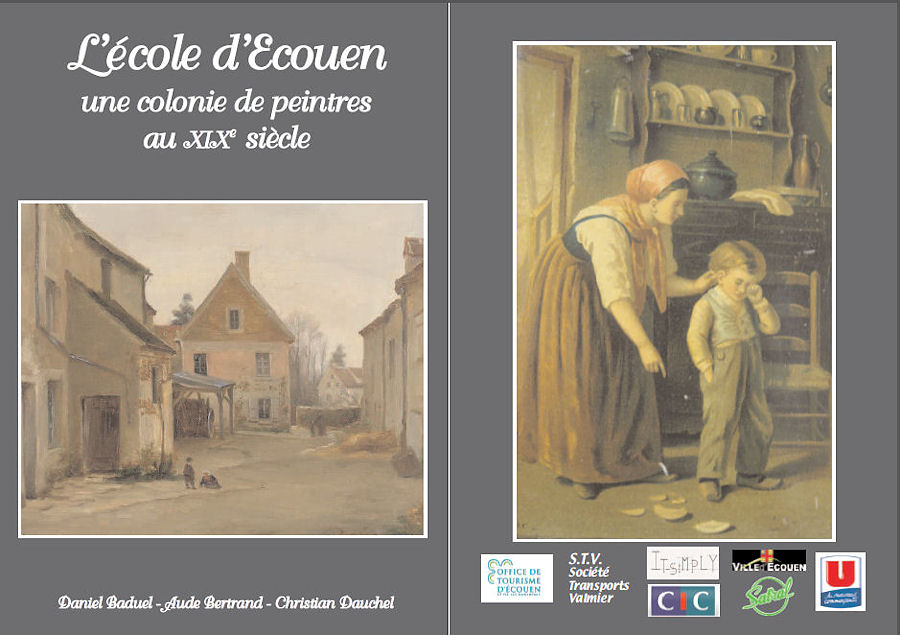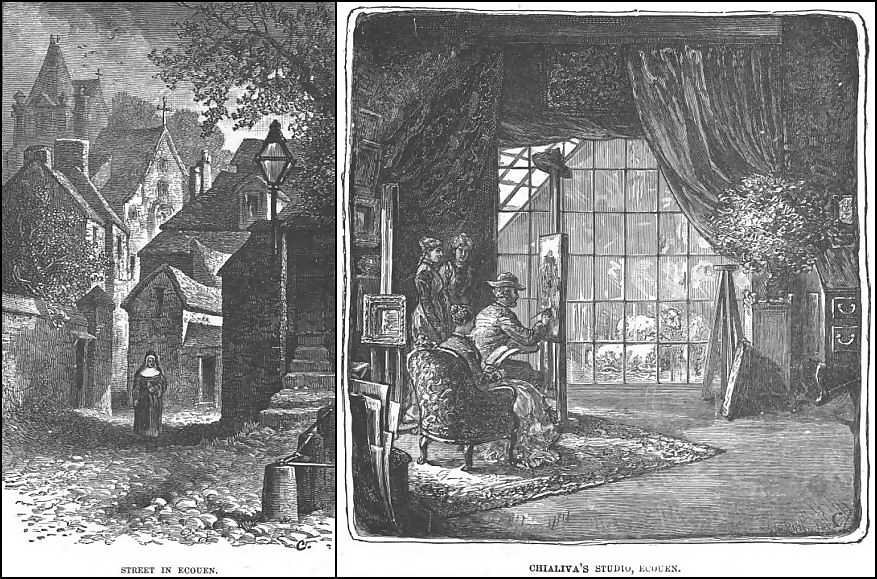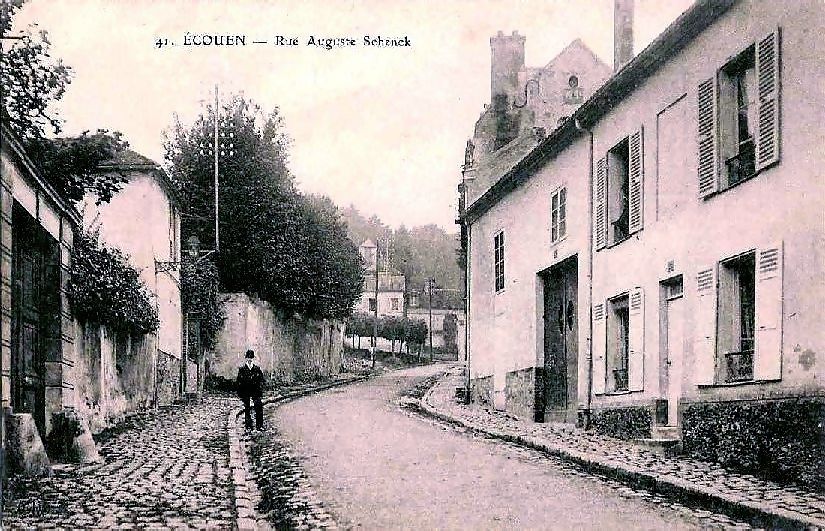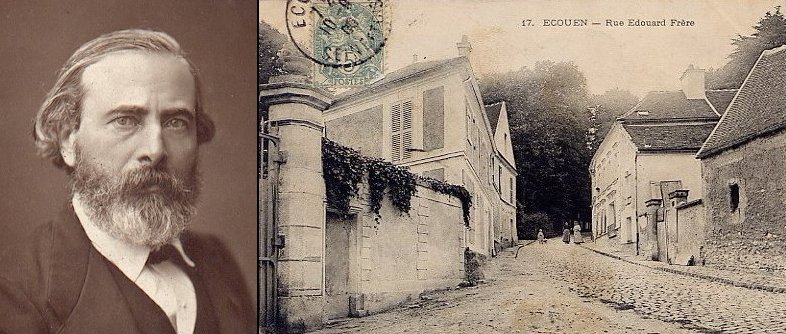ALBERT (OR ALBRECHT) SCHENCK (1828-1901)
- PAGE 04 -
DATA RELATED TO VILLE D'ÉCOUEN,
PARIS, FRANCE.
|
Albert Schenck Datapages
01,
02
&
04
are now on site. Plus all
of the image pages, accessible though the index on page
05. To search for specific text on this page, just press 'CTRL + F' & then enter your search term. This is Datapage
04 re 'Auguste (or August) Friedrich
(or Frederic) Albrecht (or Albert) Schenck'. In
late 2012, a book about the many artists of Écouen in the 19th century was published by the City of Ecouen
(Office de Tourisme d’Écouen). Entitled 'L'école d’Ecouen, une colonie de peintres
au XIXe siècle', & written by Daniel Baduel, Aude Bertrand et Christian Dauchel,
the book is available from the Tourist Information Center of Écouen who can be
contacted here.
An image of the front & back covers is next. The book, I understand, is in
French & features many artists including Auguste Schenck.
In the earlier 'Schenck' pages, It is indicated that the artist spent his retirement years in Ecouen, then a quiet village north of Paris, but now, I suspect, part of Greater Paris. I was interested to acquire, some years ago now, a book entitled 'The Boy Travellers in Central Europe'. It is in fine condition & seems to date from 1889, but it has an inscription inside the front cover dated Christmas 1934. It is a beautiful book, with a host of engravings (a couple of which are below), & some extensive words about Écouen, words that I found to be of considerable interest. While our artist is mentioned, a far greater reference is to another artist who also painted animals - a Mr. Chialiva, evidently of Italian descent. You may find the words to be of interest also, as the village setting in which Albert Schenck spent much of his life.
A couple of the engravings - a street scene in Écouen & Mr. Chialiva's studio.
Is this
the Mr. Chialiva referred to, I wonder? Luigi Chialiva, (1842-1914), but born, in fact, in Switzerland,
it would seem. One can easily forgive the author of my book for thinking that someone named Luigi would
likely be Italian! Especially when he was born in Canton Ticino in southern Switzerland, very close to the Italian border.
Here is one of the Chialiva works
entitled 'Guarding the Flock'. I read that he went to live in Paris in 1872 &
lived there for just ten years. Which is a puzzle, since my copy of 'The Boy Travellers
in Central Europe', from which I quote above, was published in 1889, when he
would have long since left Écouen. I do not know where he next lived. He was
born, it would seem, on Jul. 16, 1842 and died in Apr. 1914. He was buried in
Cimetiere St. Vincent, Montmartre, Paris, France.
So maybe he later returned to Paris. An image of the artist is available at that link
but not one of his gravestone that I can see. And another image of Chialiva's studio, most similar to the one above. This image was published in Harper's New Monthly, in Feb. 1885, in an article that some day I might like to include in its entirety in these pages. Since it sounds most interesting. That article was described in an Dec. 2005 e-Bay item as being 'An Art Student in Ecouen by Cornelia W. Conant. Illustrations. Drawn by the Author. Edouard Frere's Studio. Ploughing. The Chateau. Gleaning. Street in Ecouen. Studio of Luigi Chialiva. Mere Cocotte.' It would be good to locate an image of Schenck's studio, however, in addition to that of Luigi Chialiva. I now find that the entire article is available at the fine Cornell University site & runs from page 388 through 399. The Écouen street scene is that already on the page above & Cornelia Conant's drawing of Chialiva's studio is already on this page (next below).
And next is an old postcard of Rue Auguste-Schenck in the village of Écouen. How wonderful! I have no idea as to its date, alas. I spotted a copy of this postcard sold on e-Bay in Jun. 2006 for EUR 5.00 or approximately U.S. $6.31. I later saw a similar postcard that had been postally used on a date in Jun. 1926.
And another old postcard of Rue Auguste-Schenck in the village of Écouen is also available. Taken from a few feet up the road from the above image, it would appear. I show you the image, an image which I modified for better presentation here (I mainly reduced the colour temperature). The item was for sale on Delcampe but is now long gone. Again I have no idea as to its date.
The webmaster does not search every day for e-Bay items related to
Écouen. But in Aug. 2009, as this site must move to a new location, he did spot another image of the postcard on e-Bay. Which listing dated the card to 1910/11.
This page will continue to expand as I find new data and images. But a reminder as always. This page & indeed the total site of which these pages are a minor part, are designed for a 1024 x 768 screen setting. More when I get more! Maybe YOU could provide new data or could provide a clue as to where new data might be found. I would truly welcome your input. To the Schenck Data Pages
01,
02
&
04.
Page
05 is an
image index page.
|





